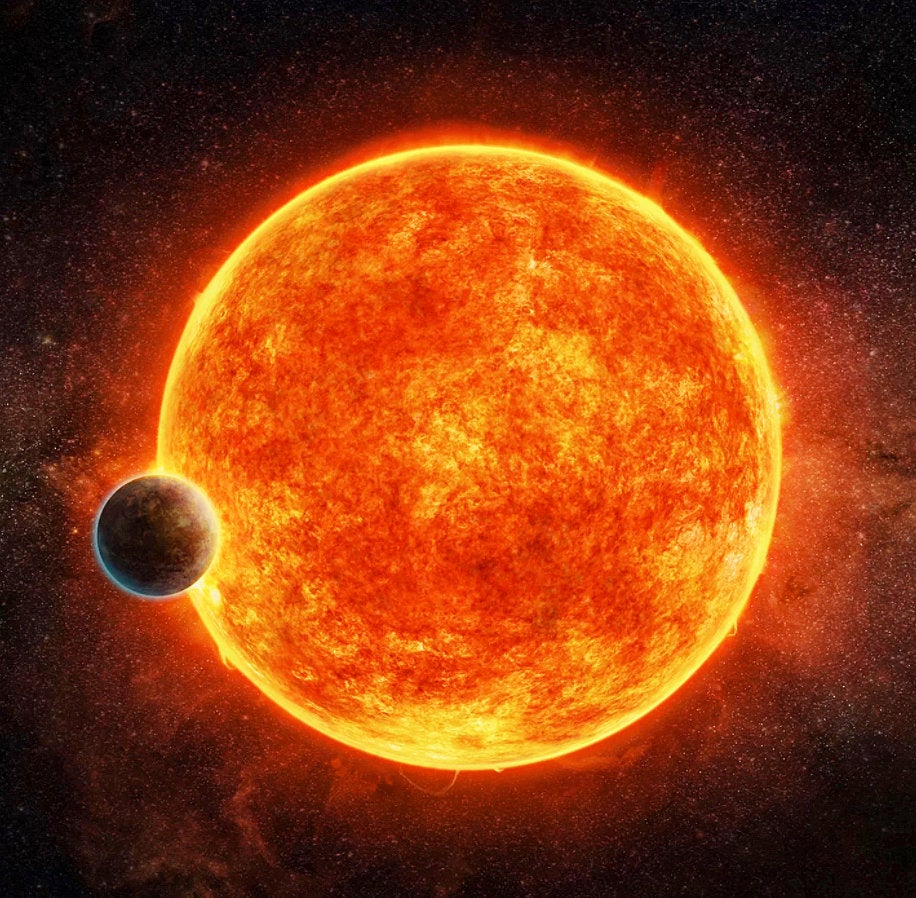
In a cosmic coup, astronomers have found a celestial beacon known as a pulsar in orbit with not one, but two other stars. The first-of-its-kind trio could soon be used to put Einstein's theory of gravity, or general relativity, to an unprecedented test. "It's a wonderful laboratory that nature has given us," says Paulo Freire, a radio astronomer at the Max Planck Institute for Radio Astronomy in Bonn, Germany, who was not involved in the work. "It's almost made to order."
A pulsar consists of a neutron star, the leftover core of a massive star that has blown up in a supernova explosion. The core's own gravity squeezes it so intensely that the atomic nuclei meld into a single sphere of neutrons. The spinning neutron star also shines out a beam of radio waves that sweeps the sky just as the light beam from a lighthouse sweeps the sea. In fact, pulsars flash so regularly that they make natural timepieces whose ticking can be as steady as that of an atomic clock.
The incredible regularity makes it possible to determine whether the pulsar is in orbit with another object, as roughly 80% of the more than 300 fast-spinning "millisecond" pulsars are known to be. As the pulsar and its companion orbit each other, the distance between the pulsar and Earth varies slightly, so that it takes more or less time for the pulses of radio waves to reach Earth. As a result, the frequency of pulsing speeds up and slows down in a telltale cycle.
But such a simple scenario couldn't explain the peculiar warbles in the frequency of pulsar PSR J0337+1715, which Scott Ransom, an astronomer at the National Radio Astronomy Observatory in Charlottesville, Virginia, and colleagues discovered in 2007 with the Robert C. Byrd Green Bank Telescope in West Virginia. Training other radio telescopes on the object, Ransom and colleagues kept it under near-constant surveillance for a year and a half. Eventually, Anne Archibald, a graduate student at McGill University in Montreal, Canada, figured out exactly what's going on.
The pulsar, which has 1.4 times the sun's mass and spins 366 times a second, is in a tight orbit lasting 1.6 days with a white dwarf star only 20% as massive as the sun. A second white dwarf that weigh 41% as much as the sun orbits the inner pair every 327 days, as Ransom and colleagues report online today in Nature. "We think that there are not more than 100 of these [trios] in our galaxy," Ransom says. "They really are one-in-a-billion objects."
The distinctive new system opens the way for testing a concept behind general relativity known as the equivalence principle, which relates two different conceptions of mass. An object's inertial mass quantifies how it resists pushing or pulling: It's easier to start a stroller rolling than a car because the stroller has less inertial mass. A thing's gravitational mass determines how much a gravitational field pulls on it: A barbell is heavier than a feather because it has more gravitational mass.
The simplest version of the equivalence principle says inertial mass and gravitational mass are equal. It explains why ordinary objects like baseballs and bricks fall to Earth at the same rate regardless of their mass—as legend claims Galileo showed by dropping heavier and lighter balls from the Leaning Tower of Pisa.
The strong equivalence principle takes things an important step further. According to Einstein's famous equation, E = mc, energy equals mass. So an object or system's mass can be generated by the energy in the gravitational fields within the system itself. The strong equivalence principle states that even if one includes mass generated through such "self-gravitation," gravitational and inertial mass are still equal. The principle holds in Einstein's theory of general relativity but typically does not hold in alternative theories, says Thibault Damour, a theoretical physicist at the Institute for Advanced Scientific Studies in Bures-sur-Yvette, France. So poking a pin in the principle would prove that general relativity is not the final word on gravity.
Researchers have already tried to test the strong equivalence principle. Since the 1970s, some have compared how the moon and Earth orbit in the gravitational field of the sun. More recently, others have analyzed the motion of pulsar–white dwarf pairs in the gravitational field of the galaxy. But those studies have been limited, Damour says. Earth's self-gravitation accounts for just a billionth of its mass. In pulsar studies, the galaxy's gravity is very weak. So the strong equivalence principle has been tested only to a precision of parts per thousand.
The new pulsar system opens the way to a much more stringent test by combining the strengths of the two previous methods. The self-gravitation of the pulsar accounts for roughly 10% of its mass, in contrast to less than 0.001% for the inner white dwarf. At the same time, both move in the gravitational field of the outer white dwarf, which is much stronger than the field of the galaxy. By tracking the system's evolution, Ransom and colleagues should be able to tell whether either the inner white dwarf or the pulsar falls faster toward the outer white dwarf and test strong equivalence about 100 times as precisely as before, Damour says.
So will strong equivalence principle be found wanting? "I would rather expect to get a better limit" on possible violations, Damour says. "But I'm open-minded. It would be great to get a violation." Freire says a violation would be "a complete revolution."
Researchers may not have to wait long, Ransom says. His team should be able to test the principle within a year.
This story has been provided by AAAS, the non-profit science society, and its international journal, Science.
